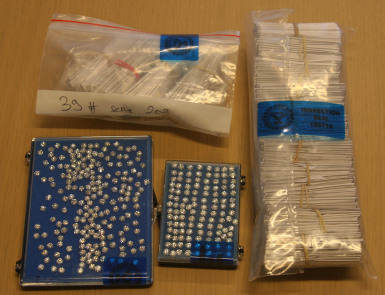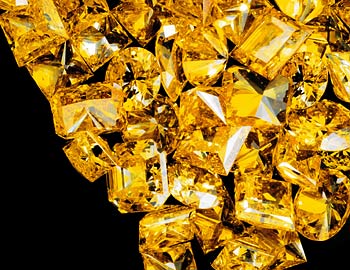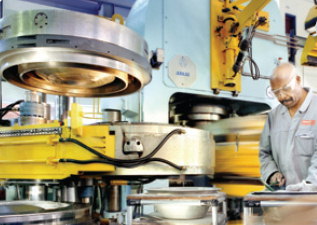NJN: What the Labs Have to Say about Undisclosed Synthetics
July 26, 12
 The undisclosed lab-made diamonds detected by IGI Photo: IGI, DIB, Chaim Even-Zohar |
Synthetic, or lab-grown, colorless diamonds created using the chemical vapor deposition (CVD) process are becoming more common in the market. And not everybody’s being honest about what they are selling.
This spring, a parcel of hundreds of CVD synthetics was submitted to the International Gemological Institute in
Diamonds in both parcels were, for the most part, of high color and clarity and ranged in size from 0.30 carats up to 0.70 carats.
This pair of parcels shared at least one other common trait: neither was submitted with proper disclosure. In the case of the diamonds in
News of what had happened in
For the industry’s grading labs, however, the identification of synthetic diamonds is not breaking news but a reality that they have spent a decade preparing to deal with, and one that leaders say they are equipped to handle.
Tom Moses, senior vice president of the GIA lab, likens the situation to that of a student who’s been dutiful about doing his homework and is well prepared for an upcoming exam.
“It makes this issue less daunting,” he says. “We have a lot of respect for it. We have invested a lot in it. But I must say we have a kind of quiet confidence that we really feel that we can deal with this situation.”
The science behind synthetics
While the heads of the world’s largest grading labs can’t give an exact year, they all date the practice of screening for synthetics back to the late 1990s.
Peter Yantzer, executive director of American Gem Society Laboratories (AGS Lab), specifically recalls making a trip to
Shortly after this trip across the pond, first-generation DiamondSure and DiamondView machines arrived in the
“De Beers, they saw what was going on,” Yantzer says. “Kudos to them.”
As the GIA noted in an article in its summer 2009 edition of Gems & Gemology, knowledge of diamond type is what helps labs better determine if a diamond is natural, treated or synthetic.
According to the article, which cites decades of research, diamonds can be sorted into one of two broad Type categories. Type I diamonds, which contain nitrogen impurities, and Type II diamonds, which lack the former. The types are further broken down in type Ia (aggregated nitrogen impurities), type Ib (isolated single nitrogen impurities), type IIa (no nitrogen or boron impurities) and type IIb (boron impurities). (Type I diamonds are broken down further into types 1aA and 1aB.)
 |
When gemologists place a diamond in the DiamondSure, they are checking for a spectroscopic characteristic of a type Ia diamond; basically to see if the diamond is instantly recognizable as natural or if it needs to go on for further testing.
Those diamonds flagged by the DiamondSure go on for further analysis and expert interpretation, which can include De Beers’ other machine, the DiamondView.
The DiamondView blasts stones with high-energy UV radiation to allow for real-time imaging of fluorescence features in diamonds, exposing their growth structure.
Moses says that diamonds grown in a lab using the CVD or HPHT process exhibit a telltale growth pattern that consistently gives them away as being manmade. For example, the crop of 10 synthetics recently submitted to GIA Hong Kong exhibited “typical CVD growth striations” when placed in the DiamondView, the GIA said.
“No matter what you do to treat or disguise synthetics, those two growth features, in HPHT and CVD, cannot be removed. It can’t be changed,” he says.
This DiamondView fluorescence image of a diamond grown using the high-pressure, high-temperature process (HPHT) shows the four-fold growth sectors typical of HPHT synthetics. (Photo: Gemological
Another aspect of the synthetic market that Moses doesn’t see changing is the ability to determine if a stone is natural or synthetic with a single tool. During a presentation to the Diamond Manufacturers and Importers Association of America in
Moses also has expressed skepticism about the DiamaPen, the $199 pen-shaped device said to be able to instantly discern lab-grown yellow diamonds from their natural counterparts. The DiamaPen’s capabilities currently are being tested by both GIA and IGI.
Mitch Jakubovic, director at EGL
“Although we have not tested this new device (the DiamaPen), the development of a single inexpensive unit that can instantly identify mined diamonds from synthetics seems very unlikely,” he says. “In some instances, multiple tests may be needed to determine if a diamond is a natural or lab grown and it would be very difficult to imagine a machine that can implement all those pieces.”
He adds that some of the advanced pieces of equipment used in the process generate graphs that are, in turn, read and interpreted by senior researchers, all of which create a story about each individual stone.
The labs' role
The latest crop of undisclosed synthetic diamonds to appear on the market-the 10 diamonds submitted to GIA Hong Kong-were the first such submission from this particular client, Moses says.
While GIA does not disclose client names, the July Gems & Gemology eBrief announcing the submission mentioned one very familiar name: Gemesis. The lab-grown diamond company is also the one linked to the large parcel of synthetics submitted to IGI in
The eBrief stated that the diamonds had gemological and spectroscopic features “similar to those observed in Gemesis CVD synthetic diamonds, suggesting that post-growth annealing at high temperature was used on the diamonds to improve their color and possibly their transparency.”
 |
The technology for growing colorless diamonds using the CVD process has improved. In turn, the stones themselves are larger and of higher quality and are showing up more frequently in grading labs around the world.
It was little more than two years ago, May 2010, when the GIA identified its first near-colorless, CVD-grown diamond that weighed more than a carat. “Clearly, CVD synthetic diamonds of better quality and size are being produced as the growth techniques continue to improve,” the GIA stated at the time.
It’s not unnatural that industry players looking to turn a profit would resort to selling synthetic stones as natural. As Jerry Ehrenwald, president and CEO of IGI North and
The introduction of the seemingly inevitable criminal element, however, raises questions about the labs' role in bringing those that attempt to defraud to justice.
At GIA, Moses says that the first time a client submits synthetic diamonds without proper disclosure, such as just happened in
If it keeps happening, though, he says the GIA has the right to stop doing business with the client and, if circumstances warrant, to notify appropriate trade organizations, trading bourses and even law enforcement.
Other labs agree on making the industry aware but stop short of wanting to be the ones to bring in the law.
IGI Worldwide co-CEO Roland Lorie says that when the parcel of hundreds of undisclosed synthetic stones came into their lab, it contacted the Belgian Federation of Diamond Bourses. “People come to us because we are the experts. We are not the ones to decide who is dealing honestly or not,” he says, when asked why the lab did not reach out to law enforcement authorities. “People come to us just to know what they have in their hands, because a lot of times they don’t know.
“We are not there to take up the role of any of the industry’s authoritative and regulatory associations," he says. "Otherwise, there’d be no reason for those associations to exist.”
If IGI Worldwide perceives that there is a potential problem with a client, Lorie says, then it contacts the diamond bourses, which are responsible for the integrity of their members.
He says IGI is still doing business with the unnamed client that submitted the parcel of hundreds of undisclosed synthetics. “He didn’t know, and the bourses agreed that he didn’t know,” he says. “The person who sold it to him probably knew.”
As to whether or not members of the industry are being aggressive enough in the case, Lorie's answer is, simply, that the industry should be aggressive.
“For the moment, I haven’t heard anything. I didn’t hear about anyone that was punished or expelled or suspended from the bourse,” he says.
Jakubovic says EGL also would notify industry organizations if confronted with a situation involving hundreds of synthetics, such as IGI was, though he is quick to point out that EGL USA hasn’t had that happen. The lab has had many synthetic diamonds submitted without disclosure over the years but only in smaller amounts-a few stones here and there from varying sources-and the lab doesn’t believe there was intent to defraud in the vast majority of those cases.
“There are definitely people in this industry who are inappropriate, without a doubt,” he says. “But is it our place to get law enforcement involved? I don’t think so.”
However, Jakubovic says, if faced with an “extreme circumstance” the lab would consult with its legal advisors. “This has to be contained. The end consumer has to be protected,” he says. “Our responsibility as a major laboratory has grown and will continue to grow as these are in the marketplace.”